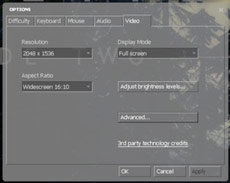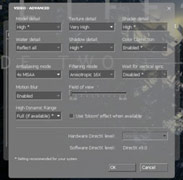ECS Hydra Watercooled 9800 GTX+ SLI pack
Written by Harry Butler
October 9, 2008 | 12:05
Tags: #9800-gtx #gpu #hydra #kit #rubbish #sli #water #waterblock #water-cooled #water-cooling
Companies: #ecs #thermaltake

Half Life 2: Episode Two
Publisher: ValveAs one part of our game of the year 2007, Half-Life 2: Episode Two set a new high in narrative and gameplay for the series. Using Valve's widely used, albeit not overly hardware intensive, Source engine that also features as a part of legendary games like Counter-Strike, Team Fortress 2 and Portal, we were keen to feature its performance here too.
The Source engine is the most scalable engine we test. While it still supports only DirectX 9.0, it features effects like dynamic lighting with HDR effects, motion blur, advanced Havok Physics and high model details.
Episode Two took Half-Life outside into large open environments for the first time and we test with Gordon running through a large open level that combines forest and houses, with explosions and physics.
All in game detail settings are set to their highest levels, with HDR enabled, and for anti-aliasing MSAA was used where both settings were set from inside the game.
Half-Life 2: Episode Two
1680x1050 4xAA, 16xAF, DX9, Maximum Detail
- ATI Radeon HD 4870 X2
- ATI Radeon HD 4850 CrossFire
- Nvidia GeForce GTX 280
- Nvidia GeForce GTX 260+
- ECS GeForce 9800 GTX+ Hydra SLI
- ATI Radeon HD 4870 1GB
- Nvidia GeForce GTX 260
- ATI Radeon HD 4870 512MB
- ATI Radeon HD 3870 X2
- ATI Radeon HD 4850
- Nvidia GeForce 9800 GTX+
- Nvidia GeForce 8800 GT
-
-
157.0
-
-
-
150.0
-
-
-
147.0
-
-
-
137.0
-
-
-
136.0
-
-
-
133.0
-
-
-
131.0
-
-
-
131.0
-
-
-
115.0
-
-
-
107.0
-
-
-
105.0
-
-
-
86.0
-
0
25
50
75
100
125
150
175
Frames Per Second
-
Average
Half-Life 2: Episode Two
1680x1050 8xAA, 16xAF, DX9, Maximum Detail
- ATI Radeon HD 4870 X2
- ATI Radeon HD 4850 CrossFire
- ECS GeForce 9800 GTX+ Hydra SLI
- Nvidia GeForce GTX 280
- ATI Radeon HD 4870 1GB
- ATI Radeon HD 4870 512MB
- Nvidia GeForce GTX 260+
- Nvidia GeForce GTX 260
- ATI Radeon HD 3870 X2
- ATI Radeon HD 4850
- Nvidia GeForce 9800 GTX+
- Nvidia GeForce 8800 GT
-
-
156.0
-
-
-
149.0
-
-
-
132.0
-
-
-
129.0
-
-
-
123.0
-
-
-
120.0
-
-
-
113.0
-
-
-
106.0
-
-
-
106.0
-
-
-
97.0
-
-
-
80.0
-
-
-
63.0
-
0
25
50
75
100
125
150
175
Frames Per Second
-
Average
Half-Life 2: Episode Two
1920x1200 4xAA, 16xAF, DX9, Maximum Detail
- ATI Radeon HD 4870 X2
- ATI Radeon HD 4850 CrossFire
- Nvidia GeForce GTX 280
- ECS GeForce 9800 GTX+ Hydra SLI
- Nvidia GeForce GTX 260+
- ATI Radeon HD 4870 1GB
- ATI Radeon HD 4870 512MB
- Nvidia GeForce GTX 260
- ATI Radeon HD 3870 X2
- ATI Radeon HD 4850
- Nvidia GeForce 9800 GTX+
- Nvidia GeForce 8800 GT
-
-
148.0
-
-
-
144.0
-
-
-
137.0
-
-
-
129.0
-
-
-
124.0
-
-
-
116.5
-
-
-
115.0
-
-
-
115.0
-
-
-
99.0
-
-
-
92.0
-
-
-
90.0
-
-
-
72.0
-
0
25
50
75
100
125
150
Frames Per Second
-
Average
Half-Life 2: Episode Two
1920x1200 8xAA, 16xAF, DX9, Maximum Detail
- ATI Radeon HD 4870 X2
- ATI Radeon HD 4850 CrossFire
- ECS GeForce 9800 GTX+ Hydra SLI
- Nvidia GeForce GTX 280
- ATI Radeon HD 4870 1GB
- ATI Radeon HD 4870 512MB
- Nvidia GeForce GTX 260+
- Nvidia GeForce GTX 260
- ATI Radeon HD 3870 X2
- ATI Radeon HD 4850
- Nvidia GeForce 9800 GTX+
- Nvidia GeForce 8800 GT
-
-
146.0
-
-
-
136.0
-
-
-
118.0
-
-
-
112.0
-
-
-
108.0
-
-
-
104.0
-
-
-
97.5
-
-
-
92.0
-
-
-
91.0
-
-
-
83.0
-
-
-
67.0
-
-
-
53.0
-
0
25
50
75
100
125
150
Frames Per Second
-
Average
Half-Life 2: Episode Two
2560x1600, 4xAA, 16xAF, DX9, Maximum Detail
- ATI Radeon HD 4870 X2
- ECS GeForce 9800 GTX+ Hydra SLI
- ATI Radeon HD 4850 CrossFire
- Nvidia GeForce GTX 280
- Nvidia GeForce GTX 260+
- Nvidia GeForce GTX 260
- ATI Radeon HD 4870 1GB
- ATI Radeon HD 4870 512MB
- ATI Radeon HD 3870 X2
- Nvidia GeForce 9800 GTX+
- ATI Radeon HD 4850
- Nvidia GeForce 8800 GT
-
-
126.0
-
-
-
107.0
-
-
-
103.0
-
-
-
101.0
-
-
-
84.0
-
-
-
77.0
-
-
-
75.0
-
-
-
72.0
-
-
-
64.0
-
-
-
58.0
-
-
-
57.0
-
-
-
45.0
-
0
25
50
75
100
125
Frames Per Second
-
Average
Half-Life 2: Episode Two
2560x1600, 8xAA, 16xAF, DX9, Maximum Detail
- ATI Radeon HD 4870 X2
- ATI Radeon HD 4850 CrossFire
- Nvidia GeForce GTX 280
- ATI Radeon HD 4870 1GB
- ATI Radeon HD 4870 512MB
- Nvidia GeForce GTX 260+
- Nvidia GeForce GTX 260
- ATI Radeon HD 3870 X2
- ATI Radeon HD 4850
- Nvidia GeForce 9800 GTX+
- ECS GeForce 9800 GTX+ Hydra SLI
- Nvidia GeForce 8800 GT
-
-
116.0
-
-
-
89.0
-
-
-
76.0
-
-
-
69.0
-
-
-
62.0
-
-
-
60.0
-
-
-
56.0
-
-
-
53.0
-
-
-
49.0
-
-
-
30.0
-
-
-
29.0
-
-
-
23.0
-
0
25
50
75
100
125
Frames Per Second
-
Average
While we were not expecting either configuration to surpass the 4870 X2 in our Half Life 2: Episode Two testing, we were very surprised to see just how close the 4850 in CrossFire gets to ATI's super premium dual GPU monster. At both 1,680 x 1,050 and 1,920 x 1,200, the performance difference between the two set ups is just five percent – that's pretty amazing considering the massive price difference between the two.
The ECS GeForce 9800 GTX+ in SLI were a little less impressive, and were only able to beat out their single GPU rivals at 8xAA, until we reach 2,560 x 1,600 where with 4xAA they're able to incredibly outperform everything bar an HD 4870 X2 and then at 8xAA catastrophically run out of memory bandwidth and are reduced to the performance of a single 9800 GTX+ – such are the perils of running multiple GPU configurations.











Want to comment? Please log in.